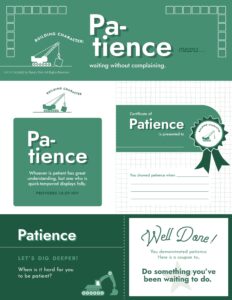Downloadable Resources to Build Patience
How to Use the Resources to Teach Patience
For a fun and structured way to build character in your kids all year long, download the calendar and stickers.
Each calendar month focuses on a unique character trait. And each character trait has a unique printable teaching resource to help you build character in your child. You can download it below.
The resource includes:
-
- definition card – to build an understanding of patience.
- verse card – to memorize why patience is important.
- question/challenge – to discuss or practice patience.
- character certificate – to recognize monthly progress in acquiring patience.
- reward coupon – to have fun and show your child how proud you are of them!
Use some or all of the resources to build patience in your child all month. You can also use the printable sticker sheet to cut out and place stickers on dates you see your child showing the trait you’re working on that month. You just need one 8.5″ x 11″ sheet of sticker paper.
Patience is just one of the 12 character traits we want to help you build in your kids. Here are more.
Why Patience Is Important for Kids
My family was eager to go on our annual cabin trip in the mountains. We packed up the bags, gathered all the car snacks, and loaded the car with essentials. We were about to spend a week in the woods with no cell reception and evenings filled with s’mores. It’s a dream come true for a parent like me.
We started on the highway and sped towards our getaway. The three kids were just as excited as the parents. We’d taken this trip before, but it had been a while since our last visit. The kids knew the drive took a long time to complete. We would be stuck in the car together for at least ten hours. But, without fail, barely an hour or so down the road we heard those famous four words from the backseat that parents will recognize all too well:
“Are we there yet?”
Kids are just like us. They don’t like to wait. The difference between kids waiting and adults waiting is adults have had more practice. Hopefully, that makes us more patient.
Patience is just the willingness to wait for what you want. This is very hard for kids no matter their stage of life. Little kids want what they want when they want it and throw temper tantrums when they don’t get it. Older kids can’t grasp why their desires aren’t being met and often act out because of it. Teens are developing big goals and dreams and those tend to take time to materialize. Each season can be a struggle in patience for children.
Learning to be patient will be incredibly beneficial for your children. It will help them handle disappointment, periods of waiting, and uncertainty. Life is full of bumps in the road. Navigating them with patience will make the ride much smoother.
How to Teach Patience to Kids
Make them wait.
Just because your child asks for something right now doesn’t mean you have to give it to them right now, even if you have the power and resources to do so. Making children wait develops patience. It can be as simple as delaying a treat for 30 minutes or as intricate as delaying your teen’s desire to date for a year. You choose but make them wait.
Set time limits on the waiting.
If you’re going to make them wait, tell them how long that period will last. This will establish a finish line and a goal. Your kids will learn that not everything lasts forever and that once you’ve gotten through a season of waiting the prize will be available.
Buy them puzzles to teach patience.
These are great tools for teaching patience. Puzzles require time and attention to complete and there are age-appropriate puzzles for every child. Start with tiny puzzles for tots and work up to 1,000-piece puzzles for teens. Do it with them for even more fun.
Read books about patience.
There are plenty of kids’ books that demonstrate good patience. Visit a local library and ask the staff which ones they recommend for the age of our child. Read the books together and discuss what the character had to endure to learn to be patient.
Bake cookies.
Kids typically like baking cookies and munching on the dough once it’s mixed. The hard part comes when you slide the tray into the oven. The treats aren’t ready until they have spent enough time in the oven to rise and get perfectly crispy. Talk to your children about why it’s hard but necessary to wait for good things, then enjoy a tasty snack after the lesson.
Teach patience by encouraging them to save money.
Fight the urge to make up the difference when the stash in your kids’ piggy banks comes up a bit shy. If the object of their desire costs $10 and they only have $7, make them work to earn the final few bucks. It will teach them that we don’t always get what we want when we want it.












